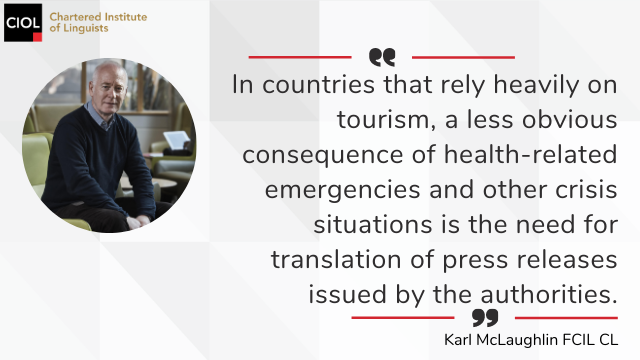-
QUALIFICATIONS
- For Linguists Worldwide
- For UK Public Services
- Preparation
- Policies & Regulation
-
MEMBERSHIP
- Join CIOL
- Professional Membership
- Affiliate Membership
- Chartered Linguist
- Already a member?
- Professional conduct
- Business & Corporate Partners
-
LANGUAGE ASSESSMENTS
- English
- All Other Languages
-
CPD & EVENTS
- Webinars & Events
- CIOL Conferences
- Networks
- CIOL Mentoring
-
NEWS & VOICES
- News & Voices
- CIOL eNews
- CIOL Awards
- The Linguist Magazine
- Jobs & Ads
-
RESOURCES
- For Translators & Interpreters
- For Universities & Students
- Standards & Norms
- CIOL & AI
- All Party Parliamentary Group
- In the UK
- UK Public Services
- Find-a-Linguist
Pitching our worth

Using metrics and corporate speak to make the case for localisation to clients in language they understand
By Melanie Morawetz
As localisation specialists in 2025, we are navigating a landscape of relentless, unforgiving change. What once felt like steady, incremental progress in CAT tools and neural machine translation (NMT) has collapsed under the massive weight of Generative AI (GenAI). The pace is dizzying, and keeping up with the developments feels like a chess game where the rules rewrite themselves mid-move.
With innovation roaring ahead, there is quiet power in deliberately reconnecting with the roots of localisation. We want to make content accessible, foster connections and gently dissolve boundaries. It is easy to see why many perceive GenAI as a silver bullet, particularly those with limited exposure to localisation workflows, but clients need to understand that forcing users to engage with poorly localised products is like running an iOS app on Windows 95: clunky, glitchy and alienating.
From backseat driver to VIP
Translation professionals now stand at an unexpected juncture. Seasoned linguists uniquely understand what ‘making content accessible’ really means: the difference between mass availability and the craft of making words resonate. This is not a call to reject natural language processing (NLP) advancements outright, but for the localisation industry to loudly position itself as a business priority, moving from the human-in-the-loop to the human-at-the-helm model, and framing it as the obvious strategic choice through compelling, strategically aligned communication. If successful, perhaps this could even phase out monolithic post-editing machine translation workflows.
In a turbulent environment with paper-thin margins, business leaders carry the weight of keeping their companies afloat. That kind of responsibility forces tough and often uncomfortable decisions. Concurrently, in the volatile political landscape, language is no longer a corporate asset but a survival tool, serving as a shield and weapon for organisations across industries. In a time when a single phrase can generate regulatory blowback and destroy reputations, words have never been more business-critical.
As linguists, we deeply understand the dangers of linguistic erosion. Therefore we must first acknowledge the legitimate business pressures driving automation. Next, we must re-learn how to translate our value into terms that resonate with those who measure success in metrics and margins, not collocations and reading flow.
A competitive edge
Paradoxically, we excel at adapting content for diverse target audiences yet struggle to articulate our own value in boardroom terms. Focusing on word count or cost-per-word is a surefire way to stay off the radar of decision makers. They do not lose sleep over misplaced idioms – they care about market capture, customer lifetime value and regulatory survival.
To shake up the narrative, freelancers must move beyond the ‘vendor’ label and be seen as strategic partners offering predictive cultural intelligence. Instead of accepting black box translation assignments, we need to pitch projects where clients share performance metrics, opening the door to continuous conversations about ‘return on investment’ (ROI). ROI is a key business metric that helps leaders evaluate the effectiveness of an initiative by comparing its benefits to its cost. Demonstrating strong ROI in localisation is crucial for securing executive buy-in and long-term investment.
Just as businesses conduct audits of technical debt, companies of all sizes can benefit from auditing their linguistic debt to reveal the financial risks involved in not localising adequately. Technical debt refers to the long-term cost of choosing quick IT fixes over robust solutions. Similarly, linguistic debt accumulates when localisation is delayed or underfunded, causing inconsistent messaging and expensive corrections. While the risks are especially pronounced for global organisations or those frequently launching products across regions, smaller businesses expanding into a new market can also benefit from this process.
For hesitant clients, we must proactively demonstrate the time saved by hyper-local transcreation, which enables them to avoid costly rebranding. A model communication to educate clients (which can be adapted to specific fields) might read: “We typically see 2-3 post-launch review cycles per market when rigid machine translation post-editing is used on creative assets. Each round takes X hours and involves content, brand and legal teams, often adding 1-2 weeks per region. You are not just paying for copy, you are buying faster market entry, less internal churn and stronger customer resonance.”
In-house localisation teams
In order to thrive, in-house localisation teams must push for direct visibility into key performance indicators (KPIs) and tie localisation efforts directly to their organisation’s business goals. KPIs are measurable values that help organisations track progress towards specific objectives. They provide teams with a data-driven way to evaluate success and guide strategic decisions. As localisation teams are not always visible at the strategic level, collaboration is essential.
Start by requesting KPIs like local revenue growth (e.g. annual recurring revenue), conversion rates (the number of users taking a desired action, such as purchasing or signing up) and average order value (the average amount spent per transaction). In the context of larger companies, partnering with regional marketing and sales leads can help link localised content releases with spikes in market-specific revenue.
Proving the value of localisation
To prove the value of localisation, ask about the changes that have happened since content was localised:
- Conversion rate: How many more visitors completed desired actions? This reveals how effectively localised content drives users to act.
- Acquisition: How many more prospects have become customers? This highlights how tailored messaging outperforms one-size-fits-all content in local markets.
- Customer retention: What percentage of customers keep paying over time? This is a strong indicator of how local experiences build more lasting loyalty and trust.
- Bounce rate: How many fewer users leave without acting? A lower bounce rate signals that users feel instantly understood, which poor localisation often fails to achieve.
- Lead generation: How easily has interest been generated? Culturally relevant messaging generates more interest than generic global campaigns.
- Market penetration: How deeply has the business infiltrated the target market? This data gives a strong indication that localisation enables meaningful entry and growth in local markets.
Another useful metric is the net promoter score (NPS), typically tracked by marketing teams, which reveals customers’ willingness to recommend products. By comparing NPS data before and after localisation, we can demonstrate the direct impact of our work on customer advocacy. Sentiment analysis tools analyse large corpora (e.g. reviews) to assess neutral, positive or negative sentiments.
Further valuable metrics include organic social shares, brand mentions, decreased support tickets and app store ratings. A monthly ‘Localisation Impact Dashboard’, using tools like SimpleKPI or Airtable, could spotlight key metrics such as revenue uplift, increased customer satisfaction and reduced error rates. By visualising these data points in one centralised view through graphs, tables or maps, stakeholders can quickly grasp the contribution of localisation to business performance, moving beyond anecdotal success stories to provide clear data.
Further tools for insight generation include Google Analytics and Matomo (metrics tracking), Microsoft Clarity (visual behaviour tracking), Brand24 and Mention (social listening and brand monitoring) and BuzzSumo (content and social analytics).
Using tools effectively
We must acknowledge that relying solely on human translation for all digital content is not scalable. The Pareto principle holds true: 80% of impact comes from 20% of activity. Our top-tier skills belong where they matter most – on mission-critical content for high-stakes audiences. To protect this focus, we should challenge the inefficiencies that drain time, starting with outdated quality assurance (QA) practices, which often generate up to 90% false positives. Instead, intelligent translation assistants powered by Agentic AI are emerging, such as RAGs (retrieval-augmented generation). These models provide more contextual feedback, empowering us to refine our work while maintaining seamless consistency across projects.
Equally, incorporating workflow automation tools like Blackbird or Writesonic can replace hours spent on Excel sheets and search engine optimisation (SEO) work. Maybe it is even time to consider a rebrand, transforming localisation teams into agile International Experience Departments?
Call to action
The call to action for CEOs is clear: invest in localisation teams as SWAT units. For translators, the message is to partner with and outsmart GenAI, but never surrender to it. Pitch like a Chief Financial Officer and demonstrate that your work multiplies budgets, not just polishes words.

Melanie Morawetz is a Senior German Localisation Specialist at Planview, where internationalisation and localisation are deeply embedded.
This article is reproduced from the Summer 2025 issue of The Linguist. Download the full edition here.
More
The Chartered Institute of Linguists (CIOL), Incorporated by Royal Charter, Registered in England and Wales Number RC 000808 and the IoL Educational Trust (IoLET), trading as CIOL Qualifications, Company limited by Guarantee, Registered in England and Wales Number 04297497 and Registered Charity Number 1090263. CIOL is a not-for-profit organisation.








